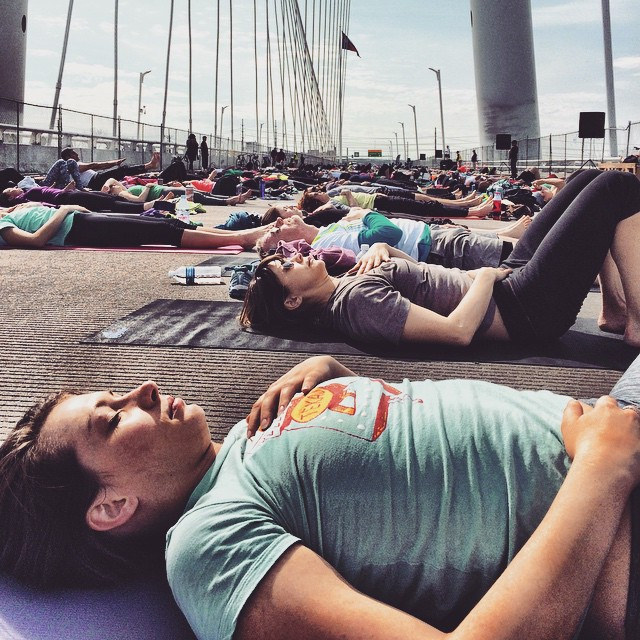I would consider my first experience of yoga nidra as both mind-blowing and one of the weirdest experiences I’ve encountered in the world of yoga.
At the time, I was regularly practicing yoga and meditation and had started to deepen my practice by trying all sorts of (what I considered to be) weird but wonderful classes from gong baths, to Kirtan, to breathwork sessions, to ecstatic dance, which eventually led me to psychic sleep, a seriously deep relaxation known as yoga nidra.
Fast forward nine years and these “unusual” practices are all part of my daily life and a major contributor to my healthy and balanced mind, body, and spirit.
I remember the first yoga nidra session distinctly.
My favourite teacher, who I had really grown to love, trust, and respect, was offering a session on yoga nidra as a special class in her beautiful yoga garden. She was super enthusiastic about it, which made me curious, so I thought, “Why not!?” Plus, she told me that after just one 30-minute session, my energy levels would be equivalent to having an eight-hour sleep—erm, yes, please!
She led the session following the traditional format of yoga nidra, which I have kindly detailed below, but in short, it starts with a detailed body scan, breath awareness, an affirmation, and a series of visualisations.
For me, the most profound aspect of this session was the body sensation visualisation, in which my teacher guided us to feel our body heavy, then light, hot, and then cold. It sounds simple, but I could not believe that my mind could control the sensations that I was feeling. I was blown away by the power of my own mind!
After the session, I felt a surge of energy and I realized how powerful my mind actually is. If it can control all my bodily sensations just from my mind—making me feel hot, cold, light, and heavy all within a few minutes, without moving or changing the environment—what else was my mind capable of?!
I didn’t realise just how impactful this session was until I reflected upon it a few months later. This short 30-minute meditation session had re-wired my brain, my beliefs about myself, and my approach to life. I moved from believing that my mind and my thoughts controlled my emotions and actions outside of my control, to discovering that I can have control of my mind, my thoughts, my feelings, and my actions.
All this from a 30-minute meditation—who would have thought it?! Certainly not me at the time.
It’s no surprise that I found a deep connection with this form of meditation, and just five months later, I found myself in India spending 23 days learning how to competently guide traditional yoga nidra techniques myself.
Since then, it has been one of my favourite techniques to share with teens and adults. I realise that not everyone may feel the effects as vividly and profoundly as I did, but imagine if they did! Imagine if we could give our students the gift of realisation—that they have control of their thoughts, feelings, and actions, the realisation that they can control their mind.
This was one of the greatest gifts that I have ever received.
If you haven’t experienced yoga nidra yet, I highly recommend it. Whether you’re leading this for your yoga students, looking to explore this independently, or you’re interested to learn more about it, here’s an easy step-by-step guide to yoga nidra:
1. Get Comfortable:
Yoga nidra can last anywhere between 20 and 90 minutes, so getting comfortable to avoid physical distractions is essential. Get into shavasana, cover yourself with a blanket, and place something comfortable under your head and neck, and then relax.
2. Detailed Body Scan:
This is the first stage to get the mind into a focused state and the body into a relaxed, sleep-like state.
In the traditional format, we start by leading a detailed body scan, focusing on each limb and joint from the right thumb up to the shoulder and down the side of the body to the toes, then moving on to do the same on the left side of the body, the back of the body from heel to head, and the front of the body from forehead to toes.
Teaching tip: in order to keep a steady and smooth pace, try taking an inhale in between saying each body part and only speaking on the exhale.
3. Breath Awareness:
By this stage, you may well have a few of your students, particularly beginners, floating in and out of a sleep-like state, and there’s always one student who’s fallen into a full deep sleep—don’t worry, this is completely normal.
Focus on each breath, counting each exhalation. Traditionally, we start from 100 and count each breath down to one, but I often start at 10—it’s just more achievable and often, actually creates more focus than starting at 100.
4. Sankalpa:
This is your positive affirmation—usually an “I am…” statement. You can encourage your students to create their own meaningful sankalpa before starting the yoga nidra session, or often, I will create the sankalpa, especially if I am leading a theme-based or teen class.
Once the sankalpa has been determined, repeat it mentally three times.
5. Visualisations:
There are a whole range of visualisation techniques to accompany yoga nidra—I could, and often do, speak about this all day long. A couple of my personal favourites include:
Body sensations: being guided through body sensations, such as feeling hot, then cold, heavy, then light.
Quick-fire visuals: this keeps the mind super focused. Usually, we focus on natural environments or elements, like a snowy mountain, a burning fire, or a gently flowing river.
Teaching tip: use the same breathing formula that I mention above to keep a steady pace.
6. Just Be:
Now that you have entered the ultimate relaxation, take some time there. Some teachers play soothing music or singing bowls in the background, but traditionally, this would be a silent space.
7. Re-Entering Your Body:
This element of meditation is often rushed and overlooked, but it’s one of the most important elements. Why bother spending 25 minutes creating a relaxed, focused, still mind and then destroying that with a rushed ending?! Think about how you want to slowly re-enter the body and the room, with the main focus on maintaining stillness, quiet, and inner peace.
8. Relax, Reflect, and Glow:
Take some time to feel the profound effects, to sit in the relaxation, energy, and mental state that you have created, and to reflect in any way that feels appropriate to you.
~
Relephant:
How Yoga Nidra Saved me from a Life-Threatening Disease.
~
Author: Laura McEgan
Image: Josh Tremper/Flickr
Editor: Catherine Monkman
Copy & Social Editor: Sara Karpanen
 Share on bsky
Share on bsky






Read 1 comment and reply